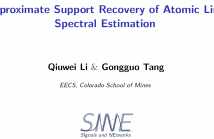
- Read more about MMSE Adaptive Waveform Design for a MIMO Active Sensing System Tracking Multiple Moving Targets
- Log in to post comments
- Categories:
 8 Views
8 Views
- Categories:
 17 Views
17 Views
- Read more about Toeplitz Matrix-based Transmit Covariance Matrix of Colocated MIMO Radar Waveforms for SINR Maximization
- Log in to post comments
ID2067---2018-ICASSP.pdf
- Categories:
 25 Views
25 Views
- Read more about COHERENT TIME REVERSAL SUB-ARRAY PROCESSING FOR MICROWAVE BREAST IMAGING
- Log in to post comments
- Categories:
 16 Views
16 Views
- Read more about Constant Modulus Probing Waveform Design for MIMO Radar via ADMM Algorithm
- Log in to post comments
In this paper, we design constant modulus probing waveforms with low correlation sidelobes for colocated multi-input multi-output (MIMO) radar. Through exploiting the structure of the problem, we formulate it as a non-convex consensus minimization problem. Then a customized alternating direction method of multipliers (ADMM) algorithm is proposed to solve the problem, which is guaranteed convergent to its stationary point. Numerical examples show that the proposed approach offers better performance than the state-of-the-art approaches.
- Categories:
 15 Views
15 Views
- Read more about Spatial Array Thinning for Interference Cancellation under Connectivity Constraints
- Log in to post comments
Array spatial thinning is employed to select the most effective antenna elements in a large phased array for optimum performance concerning hardware and computational costs, in conjunction with managing element failure and radio interference mitigation. We formulate spatial array thinning under connectivity constraints to make the thinning applicable in large arrays. By introducing graph optimization, the problem is recast as a k-clique version of a generalized minimum clique problem.
- Categories:
 23 Views
23 Views- Read more about Efficient Single/Multiple Unimodular Waveform Design With Low Weighted Correlatioins
- Log in to post comments
A new method for designing single/multiple unimodular waveforms with good weighted correlation properties, which is
- Categories:
 13 Views
13 Views
- Read more about Approximate Support Recovery of Atomic Line Spectral Estimation: A Tale of Resolution and Precision
- Log in to post comments
This work investigates the parameter estimation performance of super-resolution line spectral estimation using atomic norm minimization. The focus is on analyzing the algorithm's accuracy of inferring the frequencies and complex magnitudes from noisy observations. When the Signal-to-Noise Ratio is reasonably high and the true frequencies are separated by $O(\frac{1}{n})$, the atomic norm estimator is shown to localize the correct number of frequencies, each within a neighborhood of size $O(\sqrt{\frac{\log n}{n^3}} \sigma)$ of one of the true frequencies.
- Categories:
 18 Views
18 Views
- Read more about Approximate Support Recovery of Atomic Line Spectral Estimation: A Tale of Resolution and Precision
- Log in to post comments
This work investigates the parameter estimation performance of super-resolution line spectral estimation using atomic norm minimization. The focus is on analyzing the algorithm's accuracy of inferring the frequencies and complex magnitudes from noisy observations. When the Signal-to-Noise Ratio is reasonably high and the true frequencies are separated by $O(\frac{1}{n})$, the atomic norm estimator is shown to localize the correct number of frequencies, each within a neighborhood of size $O(\sqrt{\frac{\log n}{n^3}} \sigma)$ of one of the true frequencies.
- Categories:
 16 Views
16 Views- Read more about Extension of Nested Arrays with the Fourth-Order Difference Co-Array Enhancement
- Log in to post comments
ICASSP2016.pdf
- Categories:
 4 Views
4 Views